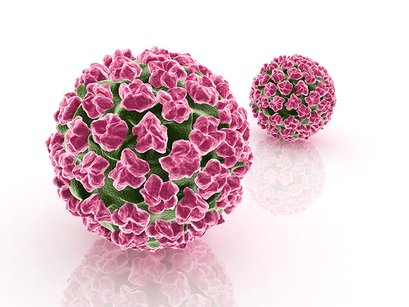Papillomavirus

Papillomaviruses are non-enveloped, icosahedral, double stranded DNA viruses with a diameter of 45 to 55 nm. They infect epithelial tissues throughout the body, leading to both benign and malignant lesions, including common and genital warts.
There are more than 100 known viral types which, based on their association with cervical cancer and precursor lesions, can be grouped into high or low risk types. At present, there is no doubt that a persistent infection of human papillomavirus, especially genotypes 16 and 18, carries a significant risk of eventually developing CIN3, or a more severe lesion at the neck of the cervix. These lesions, if left untreated, will lead to invasive cancer in most cases.
Clinical features: The infection caused by the human papilloma virus, which is usually spread by sexual intercourse, normally does not produce any symptoms when located in the cervix and / or vagina. However, if the infection site is vulvar or perineal, itchiness is common and often accentuated in the days leading up to menstruation.
Many different types of HPV exist; some strains of this virus lead to cervical cancer, other strains may cause genital warts, while others do not cause any problems at all. The development of cervical cancer is generally very slow and starts as a precancerous condition called dysplasia. This pre-cancerous condition can be detected by a Pap smear and is 100% treatable. Most of the time, cervical cancer is asymptomatic. Symptoms that may occur include continuous vaginal discharge, abnormal vaginal bleeding, heavier menstrual periods that last longer than normal, and bleeding after menopause. Symptoms of advanced cervical cancer may include loss of appetite, weight loss, fatigue, pelvic pain, back pain, leg pain, swelling in one leg only, heavy bleeding from the vagina, leaking of urine or feces from the vagina, and bone fractures.
Diagnosis: The diagnosis of HPV-induced lesions is mainly clinical. Conducting a simple biopsy (with histopathological and molecular study) may be necessary as a diagnostic support. The microbiological diagnosis of HPV infections is carried out by molecular microbiology techniques as it is a nonculturable virus, and antibody detection by serological techniques do not provide any information on the infecting genotype because they use a common antigen.
Treatment: Treatment of cervical cancer depends how advanced it is, the size and shape of the tumor, the age and general health of the woman, and her desire to have children in the future. Early cervical cancer can be cured by removing or destroying precancerous or cancerous tissues. There are various surgical ways to do this without removing the uterus or damaging the cervix, so that a woman can still have children in the future.

